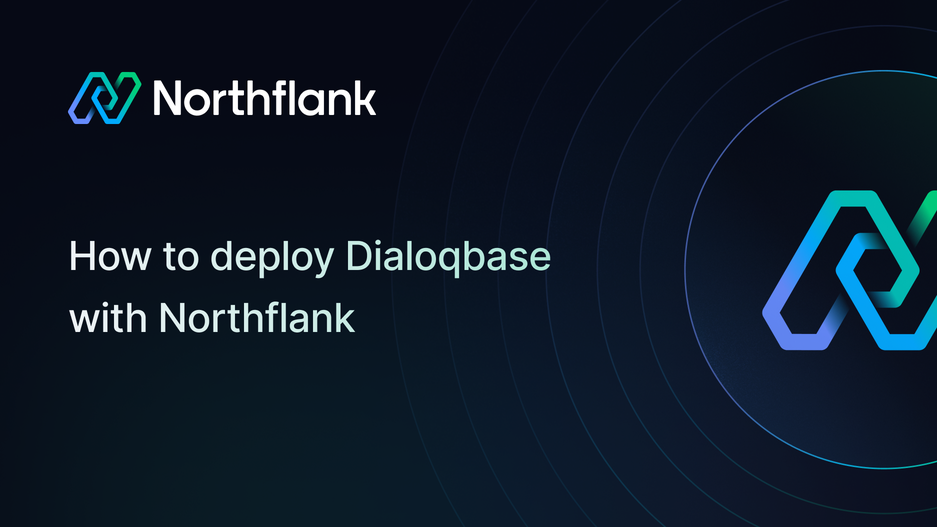

How to deploy Dialoqbase: step-by-step deployment guide
If you need a powerful yet flexible way to build and manage conversational AI applications, Dialoqbase is one of the best open-source platforms you can use. It supports multiple LLM providers, including OpenAI, Hugging Face, Anthropic, and Cohere, allowing you to create intelligent chat experiences without complex infrastructure setup.
With Northflank, you can deploy Dialoqbase in minutes using a one-click template or set everything up manually. Northflank takes care of scaling, networking, and infrastructure while you focus on building your AI applications.
Before you begin, create a Northflank account.
- Deploying Dialoqbase with a one-click template on Northflank
- Deploying Dialoqbase manually on Northflank
What is Northflank?
Northflank is a developer platform that makes it easy to build, deploy, and scale applications, databases, jobs, and even GPU workloads. It abstracts Kubernetes with smart defaults, giving you production-ready deployments without losing flexibility.
You can launch Dialoqbase on Northflank in just a few minutes using the ready-made template. This option is ideal if you want to quickly spin it up or demo the platform without performing a manual setup.
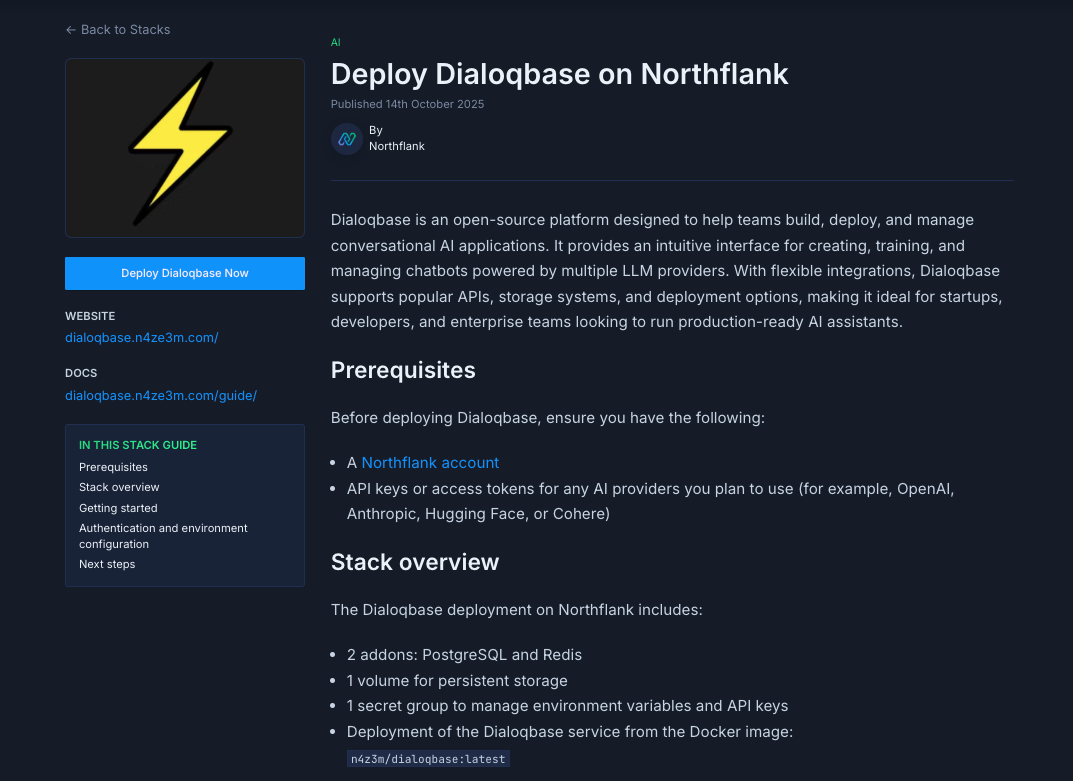
The Dialoqbase deployment on Northflank includes:
- 2 addons: PostgreSQL and Redis
- 1 volume for storing uploads and persistent data
- 1 secret group for managing environment variables and API keys
- Deployment of Dialoqbase from the Docker image:
n4z3m/dialoqbase:latest
- Visit the Dialoqbase template on Northflank.
- Click “Deploy”.
- Northflank will automatically:
- Create a project, database, Redis, volume, secret group, and service
- Deploy Dialoqbase with the required configuration
- Expose a public URL for your app
- Once live, open the URL to access the Dialoqbase interface in your browser.
Note: You’ll still need to add API keys for your LLM providers (e.g., OpenAI, Anthropic, Hugging Face).
If you want more flexibility or need to customize your setup, you can deploy Dialoqbase manually. This approach provides complete control over configuration and integration.
Note: You can also customise Northflank's one-click deploy templates.
Log in to your Northflank dashboard, click the “Create new” button (+ icon) in the top right corner of your dashboard. Then, select “Project” from the dropdown.

Projects serve as workspaces that group together related services, making it easier to manage multiple workloads and their associated resources.
You’ll need to fill out a few details before moving forward:
- Enter a project name, such as
dialoqbase-projectand optionally pick a color for quick identification in your dashboard. - Select Northflank Cloud as the deployment target. This uses Northflank’s fully managed infrastructure, so you do not need to worry about Kubernetes setup or scaling.
- (Optional) If you prefer to run on your own infrastructure, you can select Bring Your Own Cloud and connect AWS, GCP, Azure, or on-prem resources.
- Choose a region closest to your users to minimize latency.
- Click Create project to finalize the setup.
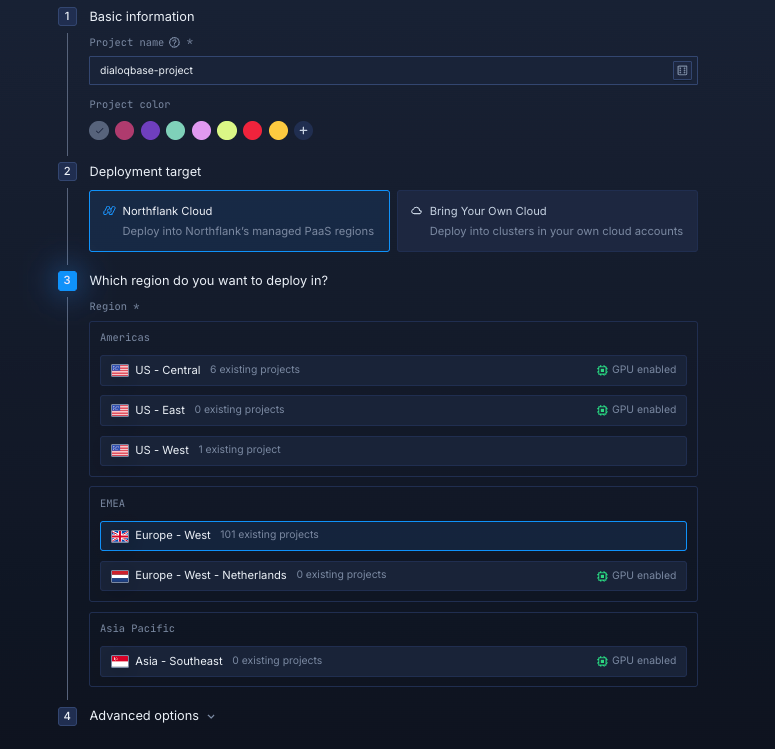
Inside your project, go to the Addons tab in the top menu and click “Create new addon”. For this deployment, you’ll need to provision two addons:
- PostgreSQL – for storing application data
- Redis – for caching and background processes
For each addon:
- Select the correct addon type (PostgreSQL or Redis)
- Give it a clear, descriptive name (e.g.
dialoqbase-dbanddialoqbase-rd) - Choose your preferred version and compute plan
Recommendation:
- For testing or development, the smallest compute plan is cost-effective and sufficient.
- For production, we recommend starting with
nf-compute-50for better performance and stability.
Once you’ve configured the settings, click Create addon to provision each one.
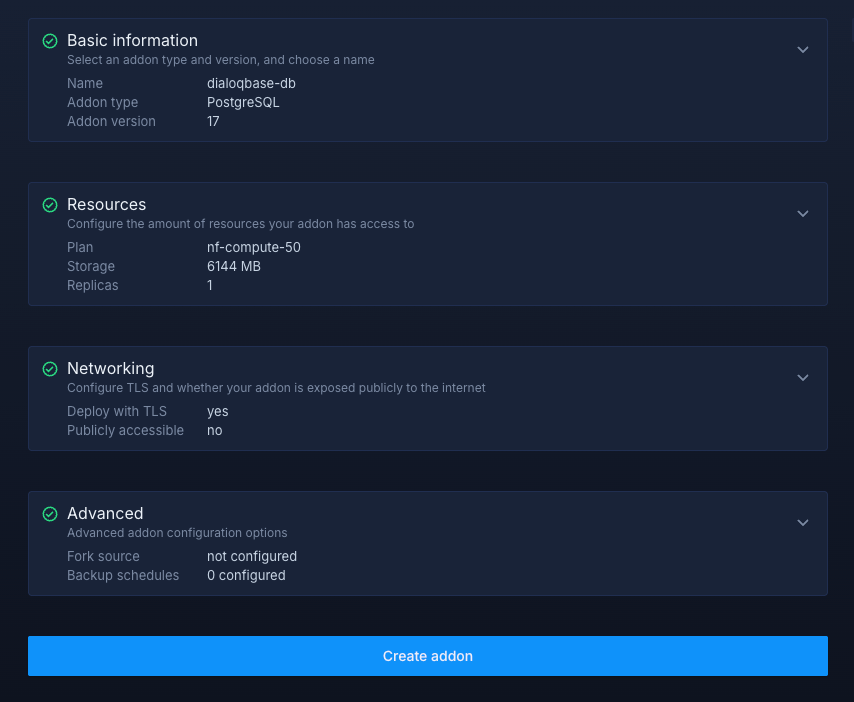
When both addons are ready, you’ll have the core infrastructure needed to run Dialoqbase smoothly.
Next, navigate to the Secrets tab and click "Create Secret Group." Name it something easy to recognize, such as dialoqbase-secrets. This group will hold all the environment variables required by Dialoqbase. You can find the full list of supported variables in the Dialoqbase documentation.
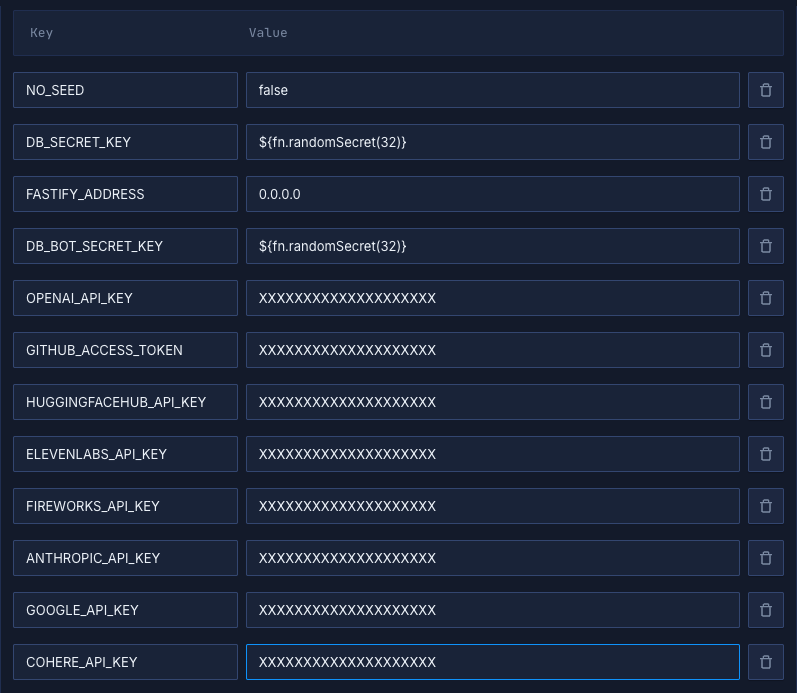
If you don't want to go through the stress of manually configuring or searching for environment variables to use, you can use the already configured ones below:
NO_SEED=false
DB_SECRET_KEY="${fn.randomSecret(32)}"
FASTIFY_ADDRESS="0.0.0.0"
DB_BOT_SECRET_KEY="${fn.randomSecret(32)}"
OPENAI_API_KEY=XXXXXXXXXXXXXXXX
GITHUB_ACCESS_TOKEN=XXXXXXXXXXXXXXXX
HUGGINGFACEHUB_API_KEY=XXXXXXXXXXXXXXXX
ELEVENLABS_API_KEY=XXXXXXXXXXXXXXXX
FIREWORKS_API_KEY=XXXXXXXXXXXXXXXX
ANTHROPIC_API_KEY=XXXXXXXXXXXXXXXX
GOOGLE_API_KEY=XXXXXXXXXXXXXXXX
COHERE_API_KEY=XXXXXXXXXXXXXXXXNotes about these values:
NO_SEEDdetermines whether initial seeding is skipped or not.FASTIFY_ADDRESSmust be set to0.0.0.0to allow external access.DB_SECRET_KEYandDB_BOT_SECRET_KEYshould be generated securely for encryption.- API keys are optional but required if you want to use the respective LLM providers.
Link the PostgreSQL and Redis addons to your secret group
Northflank addons (like PostgreSQL and Redis) expose connection details (username, password, host, etc.). Instead of manually copying these values into your secrets, you can link the addon directly to your secret group. This way, whenever the addon rotates credentials, your service automatically receives the updated values.
- Map
POSTGRES_URItoDATABASE_URL
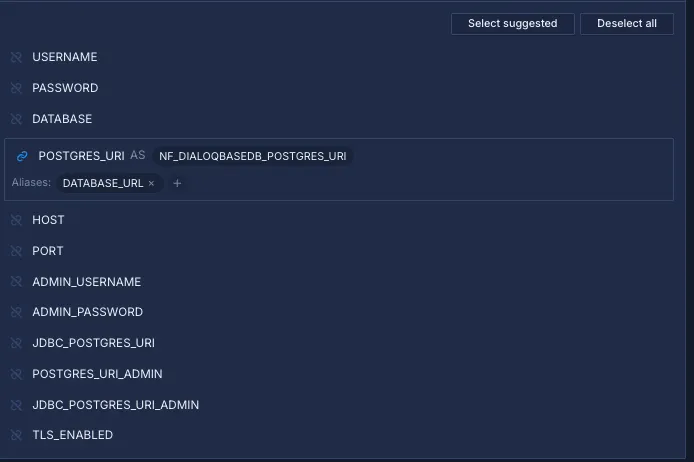
- Map
REDIS_MASTER_URLtoREDIS_URL
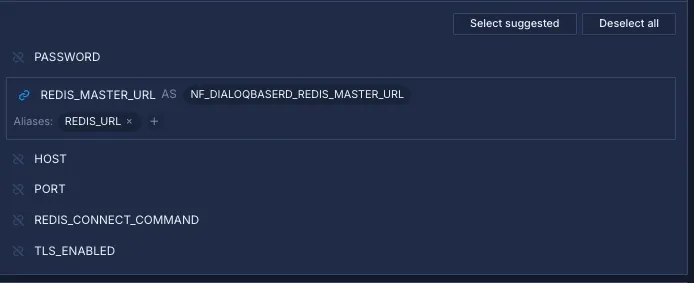
Finally, click Create secret group to save everything.
Within your project, navigate to the Services tab in the top menu and click “Create New Service.” Select Deployment and give your service a name such as dialoqbase-app.
For the deployment source, choose External image and enter the official Dialoqbase Docker image: n4z3m/dialoqbase:latest
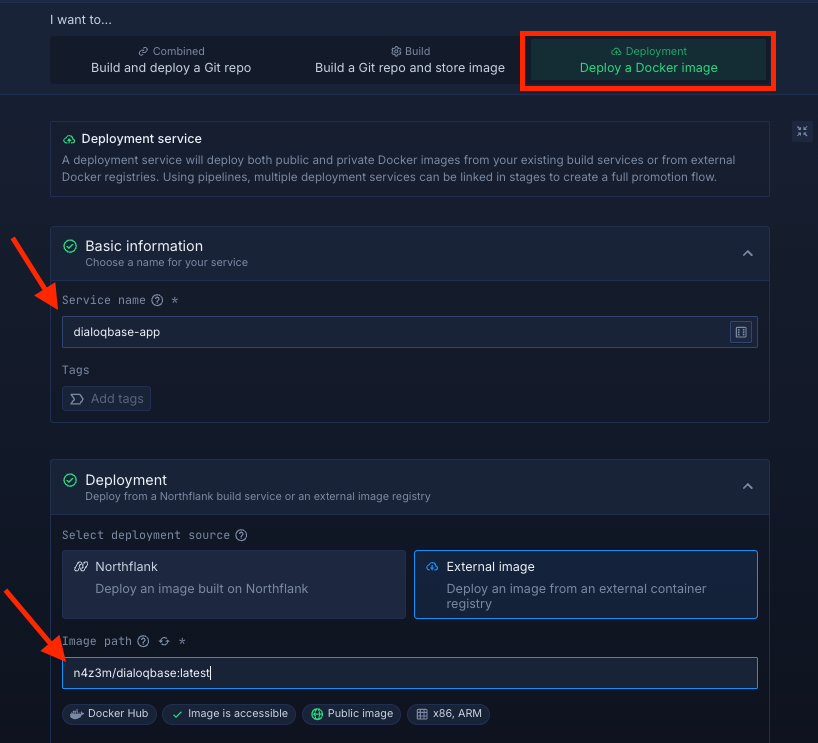
Select compute resources
Choose the compute size that best matches your workload:
- Small plans are fine for testing or lightweight usage.
- Larger plans are recommended for production, as Dialoqbase can be resource-intensive under real-world traffic.
The flexibility to adjust resources later means you can start small and scale up as your usage grows.
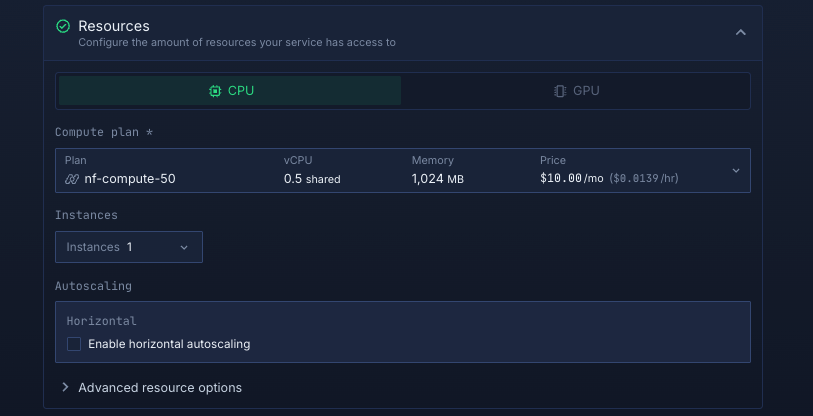
Set up a port so your app is accessible:
- Port:
3000 - Protocol:
HTTP - Public access: enable this to let people access your Dialoqbase instance from the internet
Northflank will automatically generate a secure, unique public URL for your service. This saves you from having to manage DNS or SSL certificates manually.
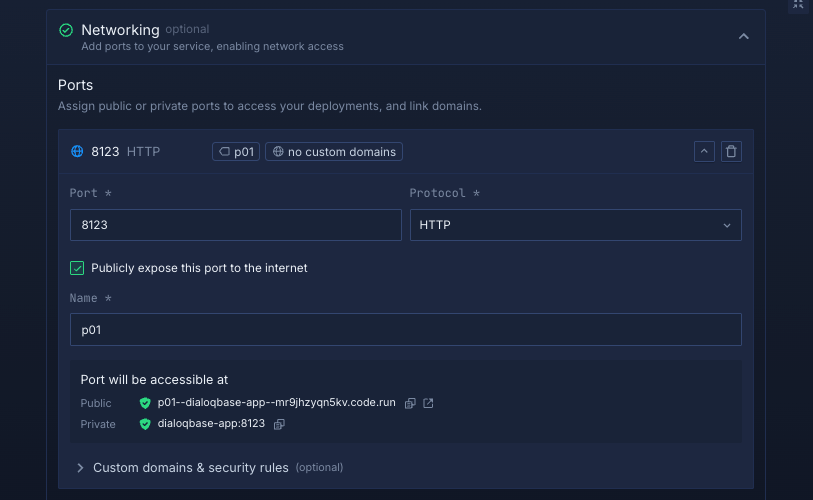
Deploy your service
When you’re satisfied with your settings, click “Create service.” Northflank will pull the image, provision resources, and deploy Dialoqbase.
Once the deployment is successful, you’ll see your service’s public URL at the top right corner, e.g.: p01--dialoqbase-app--lppg6t2b6kzf.code.run
- Inside your project, go to the Volumes tab and click Create new volume.
- Name it
dialoqbase-volume. - Choose a storage type (NVMe is recommended).
- Choose a storage size (start small for testing, scale up for production).
- Set the volume mount path to:
/app/uploads(the directory used by Dialoqbase to store data) - Attach the volume to your
dialoqbase-appservice to enable persistent storage. - Click Create volume to finalize.
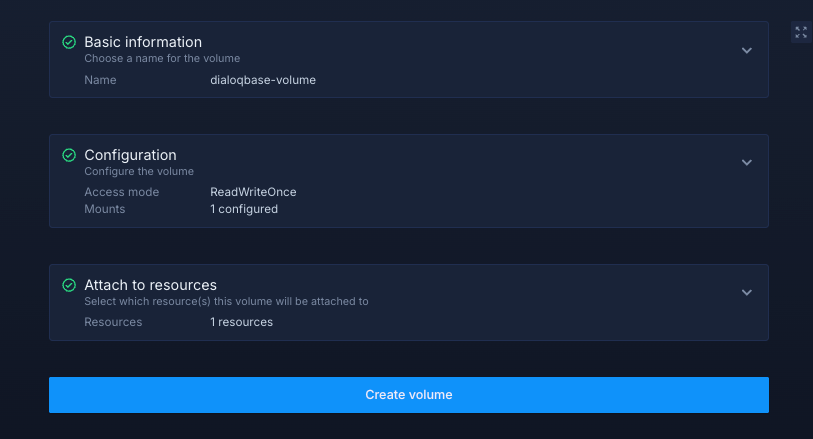
After successfully creating your volume, you need to restart your service. Once completed, you can access your deployed Dialoqbase app.
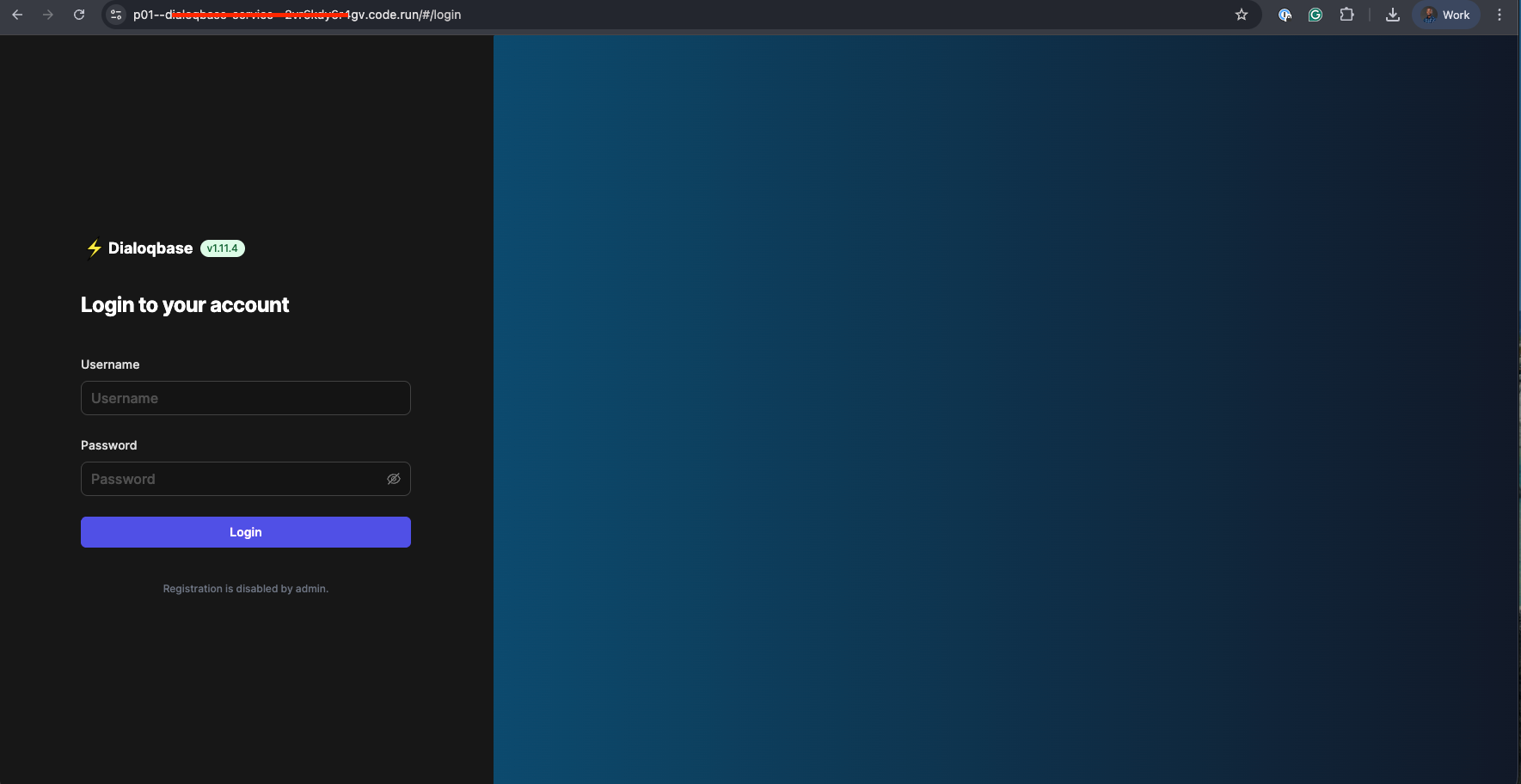
Deploying Dialoqbase on Northflank gives you a production-ready way to run your conversational AI platform without managing infrastructure.
Whether you choose the one-click template for speed or the manual setup for full control, Northflank provides the scalability and reliability, while Dialoqbase powers your AI-driven chat experiences.
Together, they make it easy to build, deploy, and scale AI chatbot applications at any size.